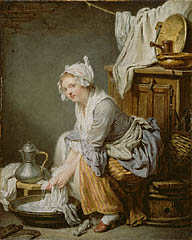Laundry Day

|
|
Two hundred and fifty years ago in France, bathing was not popular, but if you had clean clothes and clean sheets, you were considered clean, too. Many people sent their laundry to be cleaned by a laundress or washerwoman, like the one shown in this painting by the French artist Jean-Baptiste Greuze, who lived from 1725 to 1805.
How did they do laundry in France in the 1700s? Well, it took a lot longer than the washing machines and dryers we use today. First, water, ashes, and a type of baking soda were boiled in a copper pot to create a detergent. This mixture was poured into a tub filled with clothes, not much different from the one in front of this washerwoman. Then the tub was drained, and the process was repeated for eight hours. The clothes were then soaked in clean, hot water for another nine hours.
After this process, the laundry was taken to the river, where it would be scrubbed and beaten to remove dirt. The laundry was beaten with a wooden pounding device called a beetle, like the one in the lower left corner of the painting. As many as 500 laundresses gathered on the banks of the Seine river in Paris on washing day. They laid the clean clothes out to dry by the river or hung them from windows for three days. The last steps were folding and ironing. It's no wonder wealthy people sent their clothes out to be washed!

 |
 |
 |
 |
 |
 |